Service Blueprint of Langham Hotel: Opportunities and Strategies for Improvement
VerifiedAdded on 2023/06/11
|8
|2651
|222
AI Summary
This paper discusses the service blueprint of Langham Hotel and suggests ways to improve customer service and revenue levels. It highlights the opportunities for improvement and strategies to capture them. The Langham Hotel has satisfactory customer service, but there is scope for further improvement. The paper suggests enhancing customer service levels, increasing revenue levels, and enhancing the overall brand image and market position of the hotel. Strategies to capture these opportunities include higher training prospects, research and development, focus on customer satisfaction, external brand communications, brand delivery through staff, and customer participation.
Contribute Materials
Your contribution can guide someone’s learning journey. Share your
documents today.
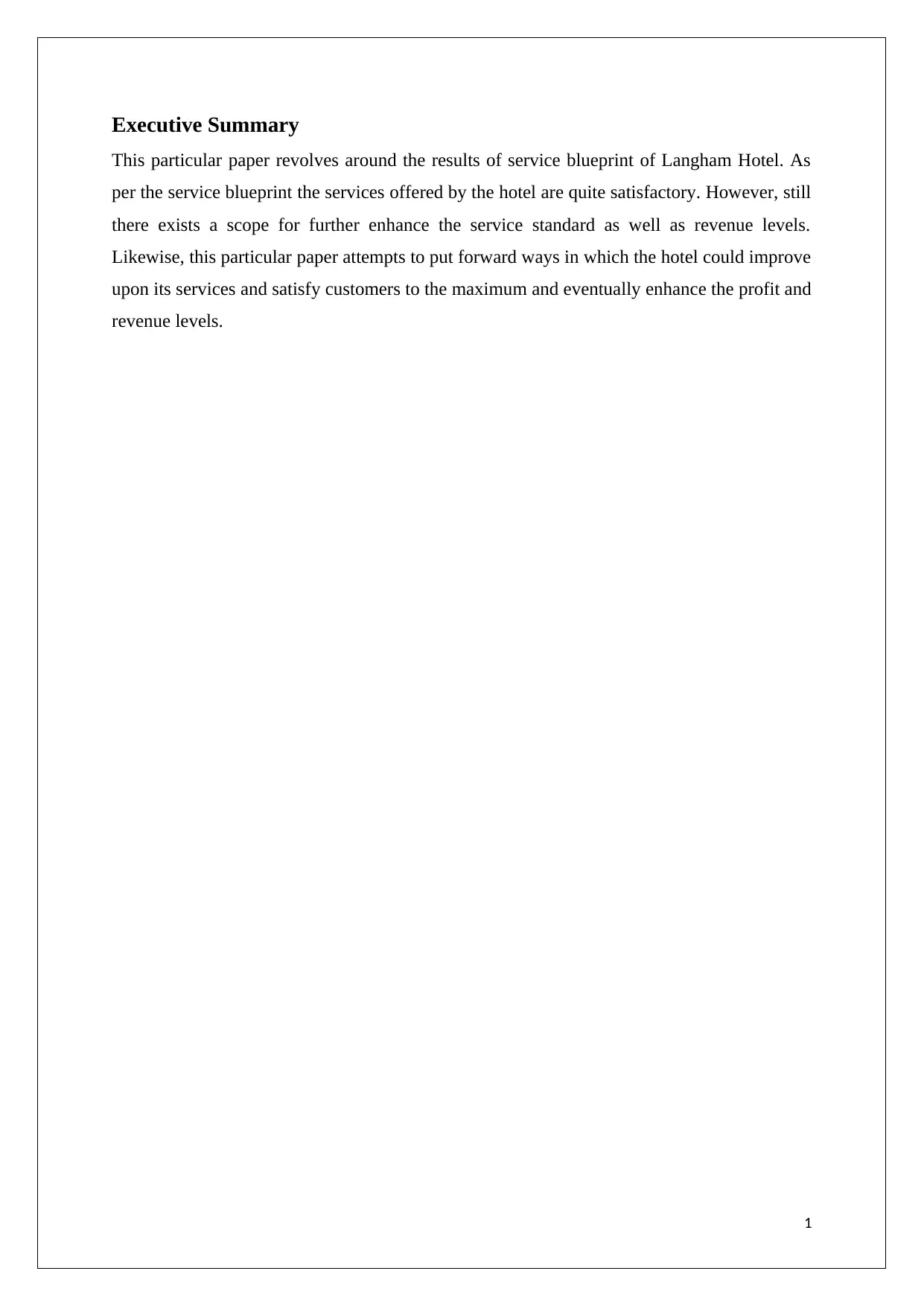
Executive Summary
This particular paper revolves around the results of service blueprint of Langham Hotel. As
per the service blueprint the services offered by the hotel are quite satisfactory. However, still
there exists a scope for further enhance the service standard as well as revenue levels.
Likewise, this particular paper attempts to put forward ways in which the hotel could improve
upon its services and satisfy customers to the maximum and eventually enhance the profit and
revenue levels.
1
This particular paper revolves around the results of service blueprint of Langham Hotel. As
per the service blueprint the services offered by the hotel are quite satisfactory. However, still
there exists a scope for further enhance the service standard as well as revenue levels.
Likewise, this particular paper attempts to put forward ways in which the hotel could improve
upon its services and satisfy customers to the maximum and eventually enhance the profit and
revenue levels.
1
Secure Best Marks with AI Grader
Need help grading? Try our AI Grader for instant feedback on your assignments.
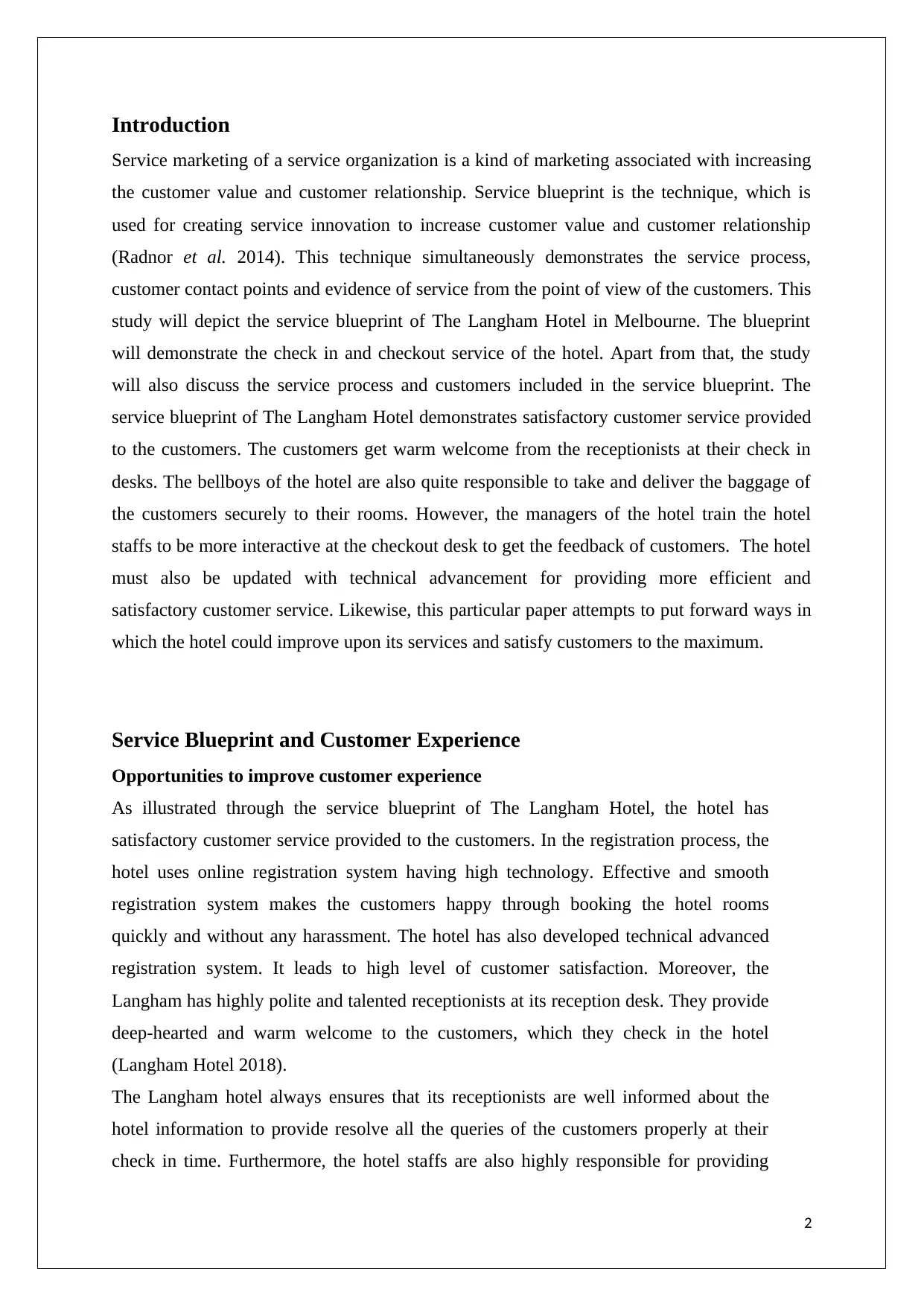
Introduction
Service marketing of a service organization is a kind of marketing associated with increasing
the customer value and customer relationship. Service blueprint is the technique, which is
used for creating service innovation to increase customer value and customer relationship
(Radnor et al. 2014). This technique simultaneously demonstrates the service process,
customer contact points and evidence of service from the point of view of the customers. This
study will depict the service blueprint of The Langham Hotel in Melbourne. The blueprint
will demonstrate the check in and checkout service of the hotel. Apart from that, the study
will also discuss the service process and customers included in the service blueprint. The
service blueprint of The Langham Hotel demonstrates satisfactory customer service provided
to the customers. The customers get warm welcome from the receptionists at their check in
desks. The bellboys of the hotel are also quite responsible to take and deliver the baggage of
the customers securely to their rooms. However, the managers of the hotel train the hotel
staffs to be more interactive at the checkout desk to get the feedback of customers. The hotel
must also be updated with technical advancement for providing more efficient and
satisfactory customer service. Likewise, this particular paper attempts to put forward ways in
which the hotel could improve upon its services and satisfy customers to the maximum.
Service Blueprint and Customer Experience
Opportunities to improve customer experience
As illustrated through the service blueprint of The Langham Hotel, the hotel has
satisfactory customer service provided to the customers. In the registration process, the
hotel uses online registration system having high technology. Effective and smooth
registration system makes the customers happy through booking the hotel rooms
quickly and without any harassment. The hotel has also developed technical advanced
registration system. It leads to high level of customer satisfaction. Moreover, the
Langham has highly polite and talented receptionists at its reception desk. They provide
deep-hearted and warm welcome to the customers, which they check in the hotel
(Langham Hotel 2018).
The Langham hotel always ensures that its receptionists are well informed about the
hotel information to provide resolve all the queries of the customers properly at their
check in time. Furthermore, the hotel staffs are also highly responsible for providing
2
Service marketing of a service organization is a kind of marketing associated with increasing
the customer value and customer relationship. Service blueprint is the technique, which is
used for creating service innovation to increase customer value and customer relationship
(Radnor et al. 2014). This technique simultaneously demonstrates the service process,
customer contact points and evidence of service from the point of view of the customers. This
study will depict the service blueprint of The Langham Hotel in Melbourne. The blueprint
will demonstrate the check in and checkout service of the hotel. Apart from that, the study
will also discuss the service process and customers included in the service blueprint. The
service blueprint of The Langham Hotel demonstrates satisfactory customer service provided
to the customers. The customers get warm welcome from the receptionists at their check in
desks. The bellboys of the hotel are also quite responsible to take and deliver the baggage of
the customers securely to their rooms. However, the managers of the hotel train the hotel
staffs to be more interactive at the checkout desk to get the feedback of customers. The hotel
must also be updated with technical advancement for providing more efficient and
satisfactory customer service. Likewise, this particular paper attempts to put forward ways in
which the hotel could improve upon its services and satisfy customers to the maximum.
Service Blueprint and Customer Experience
Opportunities to improve customer experience
As illustrated through the service blueprint of The Langham Hotel, the hotel has
satisfactory customer service provided to the customers. In the registration process, the
hotel uses online registration system having high technology. Effective and smooth
registration system makes the customers happy through booking the hotel rooms
quickly and without any harassment. The hotel has also developed technical advanced
registration system. It leads to high level of customer satisfaction. Moreover, the
Langham has highly polite and talented receptionists at its reception desk. They provide
deep-hearted and warm welcome to the customers, which they check in the hotel
(Langham Hotel 2018).
The Langham hotel always ensures that its receptionists are well informed about the
hotel information to provide resolve all the queries of the customers properly at their
check in time. Furthermore, the hotel staffs are also highly responsible for providing
2
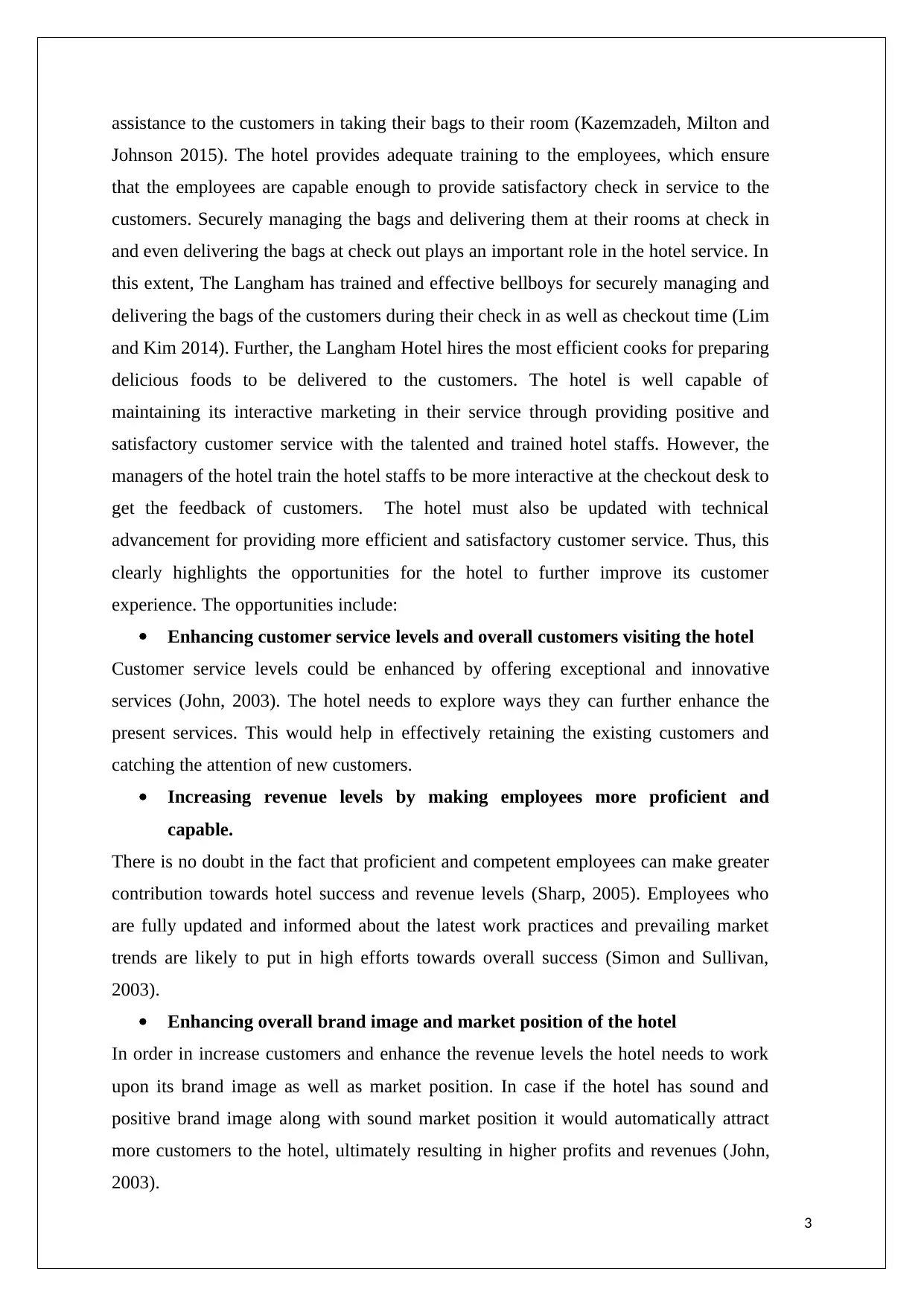
assistance to the customers in taking their bags to their room (Kazemzadeh, Milton and
Johnson 2015). The hotel provides adequate training to the employees, which ensure
that the employees are capable enough to provide satisfactory check in service to the
customers. Securely managing the bags and delivering them at their rooms at check in
and even delivering the bags at check out plays an important role in the hotel service. In
this extent, The Langham has trained and effective bellboys for securely managing and
delivering the bags of the customers during their check in as well as checkout time (Lim
and Kim 2014). Further, the Langham Hotel hires the most efficient cooks for preparing
delicious foods to be delivered to the customers. The hotel is well capable of
maintaining its interactive marketing in their service through providing positive and
satisfactory customer service with the talented and trained hotel staffs. However, the
managers of the hotel train the hotel staffs to be more interactive at the checkout desk to
get the feedback of customers. The hotel must also be updated with technical
advancement for providing more efficient and satisfactory customer service. Thus, this
clearly highlights the opportunities for the hotel to further improve its customer
experience. The opportunities include:
Enhancing customer service levels and overall customers visiting the hotel
Customer service levels could be enhanced by offering exceptional and innovative
services (John, 2003). The hotel needs to explore ways they can further enhance the
present services. This would help in effectively retaining the existing customers and
catching the attention of new customers.
Increasing revenue levels by making employees more proficient and
capable.
There is no doubt in the fact that proficient and competent employees can make greater
contribution towards hotel success and revenue levels (Sharp, 2005). Employees who
are fully updated and informed about the latest work practices and prevailing market
trends are likely to put in high efforts towards overall success (Simon and Sullivan,
2003).
Enhancing overall brand image and market position of the hotel
In order in increase customers and enhance the revenue levels the hotel needs to work
upon its brand image as well as market position. In case if the hotel has sound and
positive brand image along with sound market position it would automatically attract
more customers to the hotel, ultimately resulting in higher profits and revenues (John,
2003).
3
Johnson 2015). The hotel provides adequate training to the employees, which ensure
that the employees are capable enough to provide satisfactory check in service to the
customers. Securely managing the bags and delivering them at their rooms at check in
and even delivering the bags at check out plays an important role in the hotel service. In
this extent, The Langham has trained and effective bellboys for securely managing and
delivering the bags of the customers during their check in as well as checkout time (Lim
and Kim 2014). Further, the Langham Hotel hires the most efficient cooks for preparing
delicious foods to be delivered to the customers. The hotel is well capable of
maintaining its interactive marketing in their service through providing positive and
satisfactory customer service with the talented and trained hotel staffs. However, the
managers of the hotel train the hotel staffs to be more interactive at the checkout desk to
get the feedback of customers. The hotel must also be updated with technical
advancement for providing more efficient and satisfactory customer service. Thus, this
clearly highlights the opportunities for the hotel to further improve its customer
experience. The opportunities include:
Enhancing customer service levels and overall customers visiting the hotel
Customer service levels could be enhanced by offering exceptional and innovative
services (John, 2003). The hotel needs to explore ways they can further enhance the
present services. This would help in effectively retaining the existing customers and
catching the attention of new customers.
Increasing revenue levels by making employees more proficient and
capable.
There is no doubt in the fact that proficient and competent employees can make greater
contribution towards hotel success and revenue levels (Sharp, 2005). Employees who
are fully updated and informed about the latest work practices and prevailing market
trends are likely to put in high efforts towards overall success (Simon and Sullivan,
2003).
Enhancing overall brand image and market position of the hotel
In order in increase customers and enhance the revenue levels the hotel needs to work
upon its brand image as well as market position. In case if the hotel has sound and
positive brand image along with sound market position it would automatically attract
more customers to the hotel, ultimately resulting in higher profits and revenues (John,
2003).
3
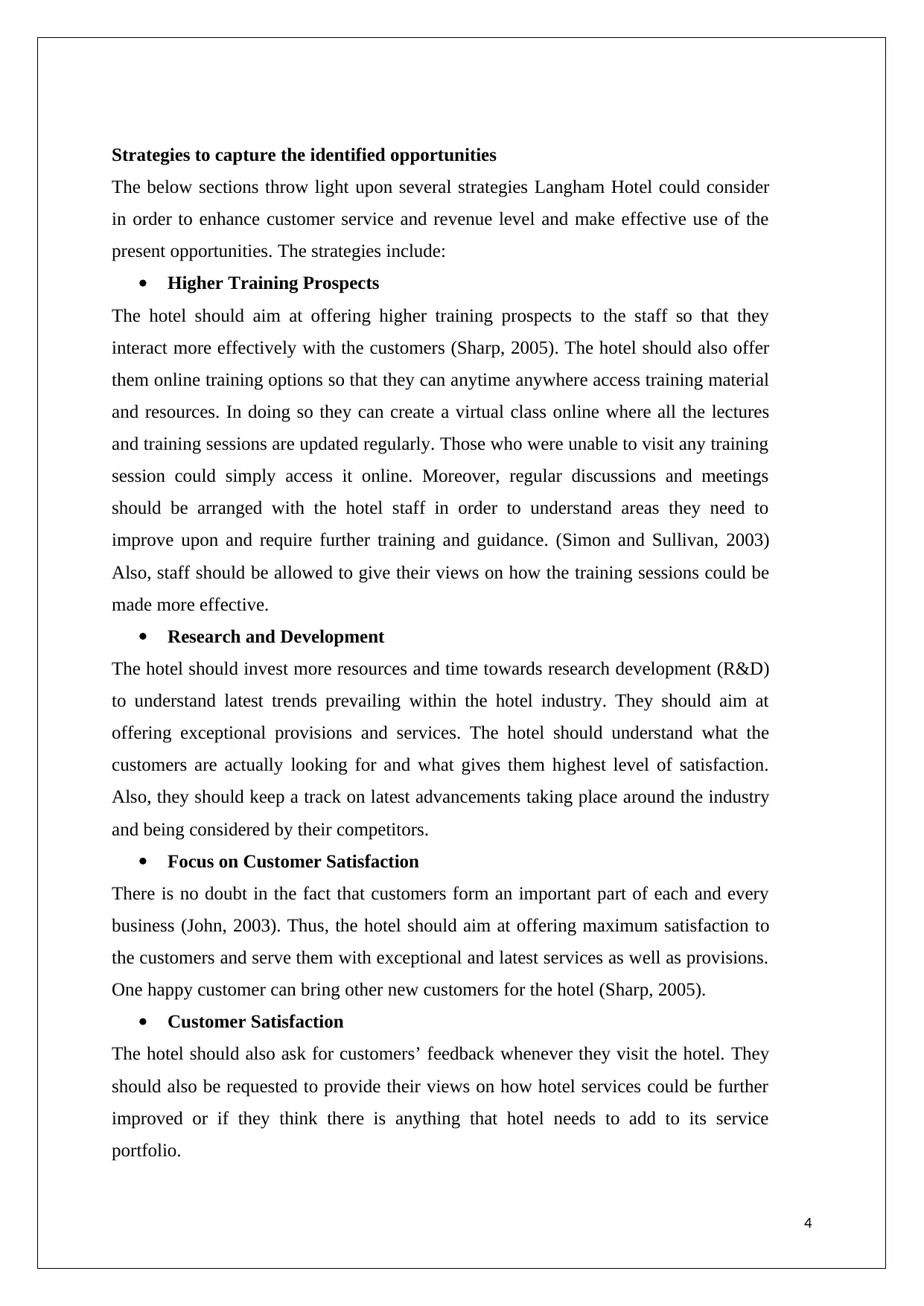
Strategies to capture the identified opportunities
The below sections throw light upon several strategies Langham Hotel could consider
in order to enhance customer service and revenue level and make effective use of the
present opportunities. The strategies include:
Higher Training Prospects
The hotel should aim at offering higher training prospects to the staff so that they
interact more effectively with the customers (Sharp, 2005). The hotel should also offer
them online training options so that they can anytime anywhere access training material
and resources. In doing so they can create a virtual class online where all the lectures
and training sessions are updated regularly. Those who were unable to visit any training
session could simply access it online. Moreover, regular discussions and meetings
should be arranged with the hotel staff in order to understand areas they need to
improve upon and require further training and guidance. (Simon and Sullivan, 2003)
Also, staff should be allowed to give their views on how the training sessions could be
made more effective.
Research and Development
The hotel should invest more resources and time towards research development (R&D)
to understand latest trends prevailing within the hotel industry. They should aim at
offering exceptional provisions and services. The hotel should understand what the
customers are actually looking for and what gives them highest level of satisfaction.
Also, they should keep a track on latest advancements taking place around the industry
and being considered by their competitors.
Focus on Customer Satisfaction
There is no doubt in the fact that customers form an important part of each and every
business (John, 2003). Thus, the hotel should aim at offering maximum satisfaction to
the customers and serve them with exceptional and latest services as well as provisions.
One happy customer can bring other new customers for the hotel (Sharp, 2005).
Customer Satisfaction
The hotel should also ask for customers’ feedback whenever they visit the hotel. They
should also be requested to provide their views on how hotel services could be further
improved or if they think there is anything that hotel needs to add to its service
portfolio.
4
The below sections throw light upon several strategies Langham Hotel could consider
in order to enhance customer service and revenue level and make effective use of the
present opportunities. The strategies include:
Higher Training Prospects
The hotel should aim at offering higher training prospects to the staff so that they
interact more effectively with the customers (Sharp, 2005). The hotel should also offer
them online training options so that they can anytime anywhere access training material
and resources. In doing so they can create a virtual class online where all the lectures
and training sessions are updated regularly. Those who were unable to visit any training
session could simply access it online. Moreover, regular discussions and meetings
should be arranged with the hotel staff in order to understand areas they need to
improve upon and require further training and guidance. (Simon and Sullivan, 2003)
Also, staff should be allowed to give their views on how the training sessions could be
made more effective.
Research and Development
The hotel should invest more resources and time towards research development (R&D)
to understand latest trends prevailing within the hotel industry. They should aim at
offering exceptional provisions and services. The hotel should understand what the
customers are actually looking for and what gives them highest level of satisfaction.
Also, they should keep a track on latest advancements taking place around the industry
and being considered by their competitors.
Focus on Customer Satisfaction
There is no doubt in the fact that customers form an important part of each and every
business (John, 2003). Thus, the hotel should aim at offering maximum satisfaction to
the customers and serve them with exceptional and latest services as well as provisions.
One happy customer can bring other new customers for the hotel (Sharp, 2005).
Customer Satisfaction
The hotel should also ask for customers’ feedback whenever they visit the hotel. They
should also be requested to provide their views on how hotel services could be further
improved or if they think there is anything that hotel needs to add to its service
portfolio.
4
Secure Best Marks with AI Grader
Need help grading? Try our AI Grader for instant feedback on your assignments.
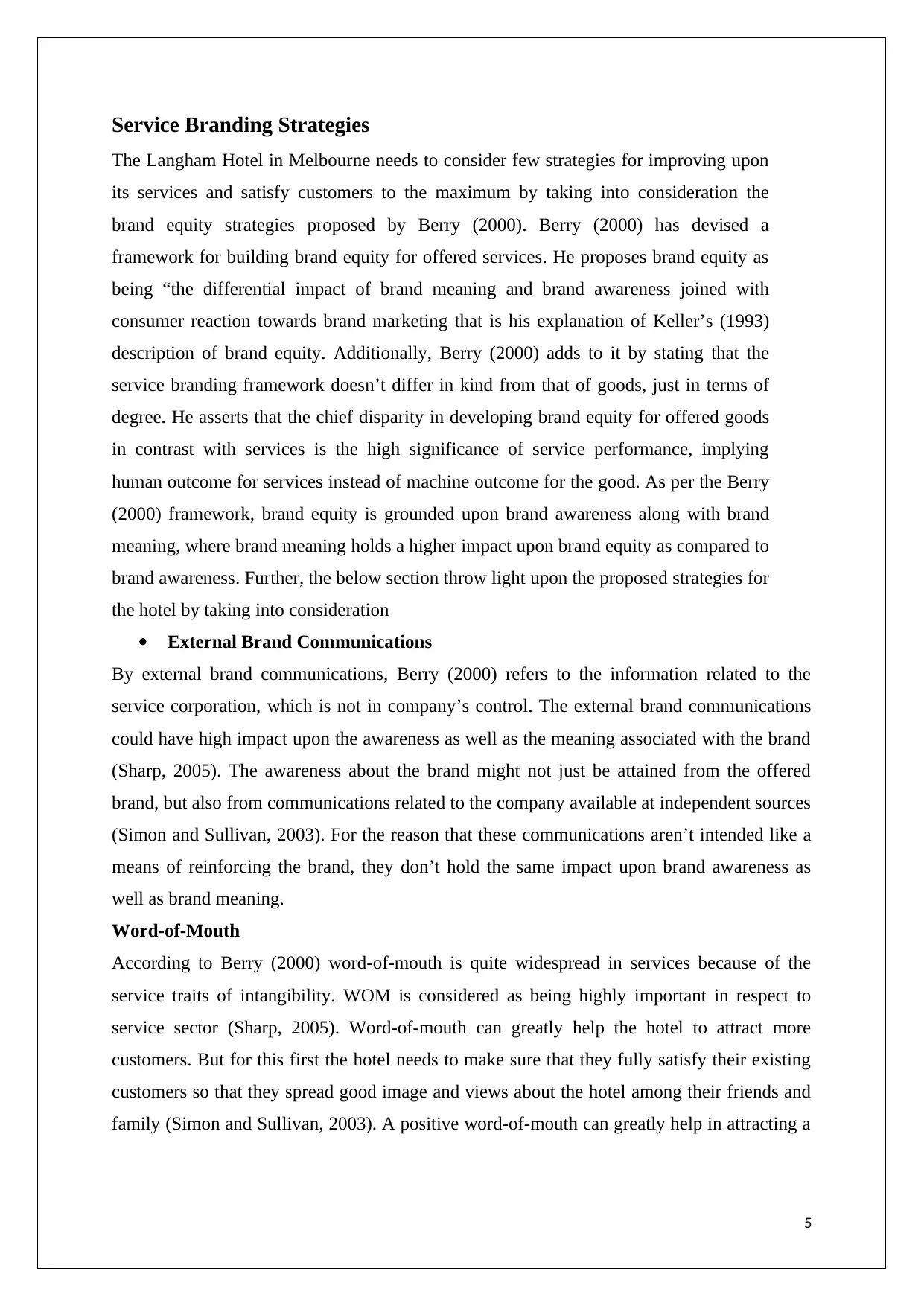
Service Branding Strategies
The Langham Hotel in Melbourne needs to consider few strategies for improving upon
its services and satisfy customers to the maximum by taking into consideration the
brand equity strategies proposed by Berry (2000). Berry (2000) has devised a
framework for building brand equity for offered services. He proposes brand equity as
being “the differential impact of brand meaning and brand awareness joined with
consumer reaction towards brand marketing that is his explanation of Keller’s (1993)
description of brand equity. Additionally, Berry (2000) adds to it by stating that the
service branding framework doesn’t differ in kind from that of goods, just in terms of
degree. He asserts that the chief disparity in developing brand equity for offered goods
in contrast with services is the high significance of service performance, implying
human outcome for services instead of machine outcome for the good. As per the Berry
(2000) framework, brand equity is grounded upon brand awareness along with brand
meaning, where brand meaning holds a higher impact upon brand equity as compared to
brand awareness. Further, the below section throw light upon the proposed strategies for
the hotel by taking into consideration
External Brand Communications
By external brand communications, Berry (2000) refers to the information related to the
service corporation, which is not in company’s control. The external brand communications
could have high impact upon the awareness as well as the meaning associated with the brand
(Sharp, 2005). The awareness about the brand might not just be attained from the offered
brand, but also from communications related to the company available at independent sources
(Simon and Sullivan, 2003). For the reason that these communications aren’t intended like a
means of reinforcing the brand, they don’t hold the same impact upon brand awareness as
well as brand meaning.
Word-of-Mouth
According to Berry (2000) word-of-mouth is quite widespread in services because of the
service traits of intangibility. WOM is considered as being highly important in respect to
service sector (Sharp, 2005). Word-of-mouth can greatly help the hotel to attract more
customers. But for this first the hotel needs to make sure that they fully satisfy their existing
customers so that they spread good image and views about the hotel among their friends and
family (Simon and Sullivan, 2003). A positive word-of-mouth can greatly help in attracting a
5
The Langham Hotel in Melbourne needs to consider few strategies for improving upon
its services and satisfy customers to the maximum by taking into consideration the
brand equity strategies proposed by Berry (2000). Berry (2000) has devised a
framework for building brand equity for offered services. He proposes brand equity as
being “the differential impact of brand meaning and brand awareness joined with
consumer reaction towards brand marketing that is his explanation of Keller’s (1993)
description of brand equity. Additionally, Berry (2000) adds to it by stating that the
service branding framework doesn’t differ in kind from that of goods, just in terms of
degree. He asserts that the chief disparity in developing brand equity for offered goods
in contrast with services is the high significance of service performance, implying
human outcome for services instead of machine outcome for the good. As per the Berry
(2000) framework, brand equity is grounded upon brand awareness along with brand
meaning, where brand meaning holds a higher impact upon brand equity as compared to
brand awareness. Further, the below section throw light upon the proposed strategies for
the hotel by taking into consideration
External Brand Communications
By external brand communications, Berry (2000) refers to the information related to the
service corporation, which is not in company’s control. The external brand communications
could have high impact upon the awareness as well as the meaning associated with the brand
(Sharp, 2005). The awareness about the brand might not just be attained from the offered
brand, but also from communications related to the company available at independent sources
(Simon and Sullivan, 2003). For the reason that these communications aren’t intended like a
means of reinforcing the brand, they don’t hold the same impact upon brand awareness as
well as brand meaning.
Word-of-Mouth
According to Berry (2000) word-of-mouth is quite widespread in services because of the
service traits of intangibility. WOM is considered as being highly important in respect to
service sector (Sharp, 2005). Word-of-mouth can greatly help the hotel to attract more
customers. But for this first the hotel needs to make sure that they fully satisfy their existing
customers so that they spread good image and views about the hotel among their friends and
family (Simon and Sullivan, 2003). A positive word-of-mouth can greatly help in attracting a
5
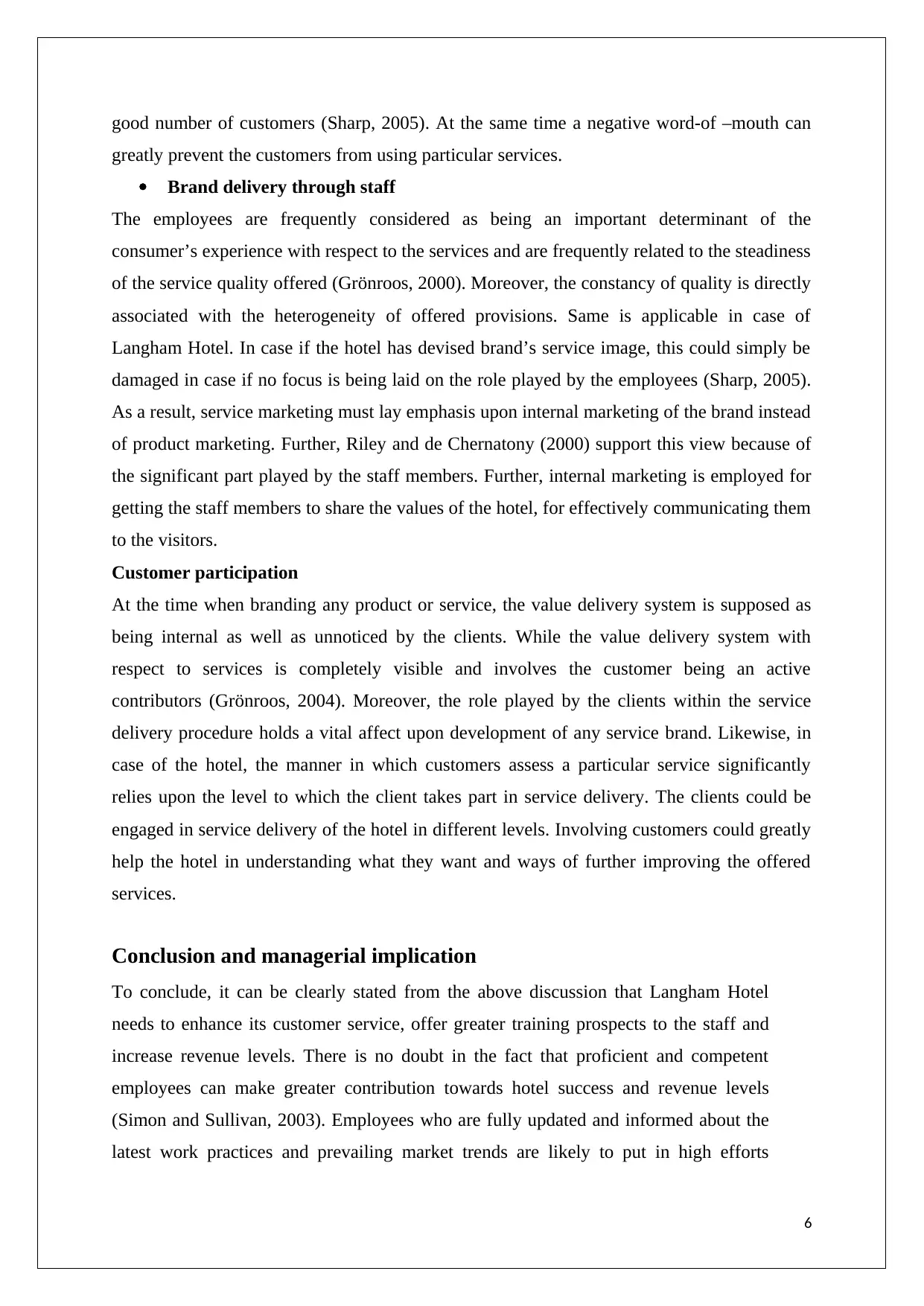
good number of customers (Sharp, 2005). At the same time a negative word-of –mouth can
greatly prevent the customers from using particular services.
Brand delivery through staff
The employees are frequently considered as being an important determinant of the
consumer’s experience with respect to the services and are frequently related to the steadiness
of the service quality offered (Grönroos, 2000). Moreover, the constancy of quality is directly
associated with the heterogeneity of offered provisions. Same is applicable in case of
Langham Hotel. In case if the hotel has devised brand’s service image, this could simply be
damaged in case if no focus is being laid on the role played by the employees (Sharp, 2005).
As a result, service marketing must lay emphasis upon internal marketing of the brand instead
of product marketing. Further, Riley and de Chernatony (2000) support this view because of
the significant part played by the staff members. Further, internal marketing is employed for
getting the staff members to share the values of the hotel, for effectively communicating them
to the visitors.
Customer participation
At the time when branding any product or service, the value delivery system is supposed as
being internal as well as unnoticed by the clients. While the value delivery system with
respect to services is completely visible and involves the customer being an active
contributors (Grönroos, 2004). Moreover, the role played by the clients within the service
delivery procedure holds a vital affect upon development of any service brand. Likewise, in
case of the hotel, the manner in which customers assess a particular service significantly
relies upon the level to which the client takes part in service delivery. The clients could be
engaged in service delivery of the hotel in different levels. Involving customers could greatly
help the hotel in understanding what they want and ways of further improving the offered
services.
Conclusion and managerial implication
To conclude, it can be clearly stated from the above discussion that Langham Hotel
needs to enhance its customer service, offer greater training prospects to the staff and
increase revenue levels. There is no doubt in the fact that proficient and competent
employees can make greater contribution towards hotel success and revenue levels
(Simon and Sullivan, 2003). Employees who are fully updated and informed about the
latest work practices and prevailing market trends are likely to put in high efforts
6
greatly prevent the customers from using particular services.
Brand delivery through staff
The employees are frequently considered as being an important determinant of the
consumer’s experience with respect to the services and are frequently related to the steadiness
of the service quality offered (Grönroos, 2000). Moreover, the constancy of quality is directly
associated with the heterogeneity of offered provisions. Same is applicable in case of
Langham Hotel. In case if the hotel has devised brand’s service image, this could simply be
damaged in case if no focus is being laid on the role played by the employees (Sharp, 2005).
As a result, service marketing must lay emphasis upon internal marketing of the brand instead
of product marketing. Further, Riley and de Chernatony (2000) support this view because of
the significant part played by the staff members. Further, internal marketing is employed for
getting the staff members to share the values of the hotel, for effectively communicating them
to the visitors.
Customer participation
At the time when branding any product or service, the value delivery system is supposed as
being internal as well as unnoticed by the clients. While the value delivery system with
respect to services is completely visible and involves the customer being an active
contributors (Grönroos, 2004). Moreover, the role played by the clients within the service
delivery procedure holds a vital affect upon development of any service brand. Likewise, in
case of the hotel, the manner in which customers assess a particular service significantly
relies upon the level to which the client takes part in service delivery. The clients could be
engaged in service delivery of the hotel in different levels. Involving customers could greatly
help the hotel in understanding what they want and ways of further improving the offered
services.
Conclusion and managerial implication
To conclude, it can be clearly stated from the above discussion that Langham Hotel
needs to enhance its customer service, offer greater training prospects to the staff and
increase revenue levels. There is no doubt in the fact that proficient and competent
employees can make greater contribution towards hotel success and revenue levels
(Simon and Sullivan, 2003). Employees who are fully updated and informed about the
latest work practices and prevailing market trends are likely to put in high efforts
6
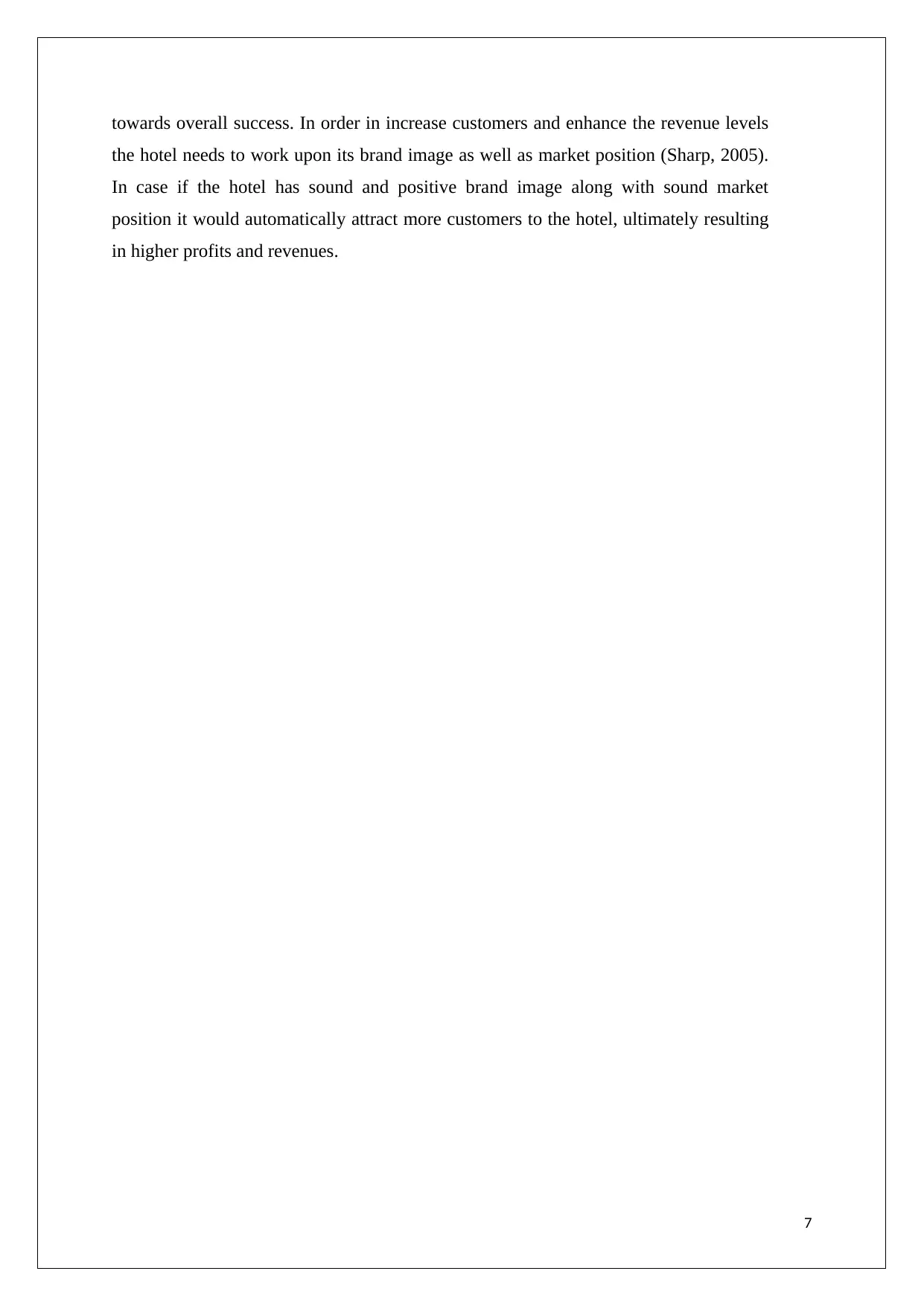
towards overall success. In order in increase customers and enhance the revenue levels
the hotel needs to work upon its brand image as well as market position (Sharp, 2005).
In case if the hotel has sound and positive brand image along with sound market
position it would automatically attract more customers to the hotel, ultimately resulting
in higher profits and revenues.
7
the hotel needs to work upon its brand image as well as market position (Sharp, 2005).
In case if the hotel has sound and positive brand image along with sound market
position it would automatically attract more customers to the hotel, ultimately resulting
in higher profits and revenues.
7
Paraphrase This Document
Need a fresh take? Get an instant paraphrase of this document with our AI Paraphraser
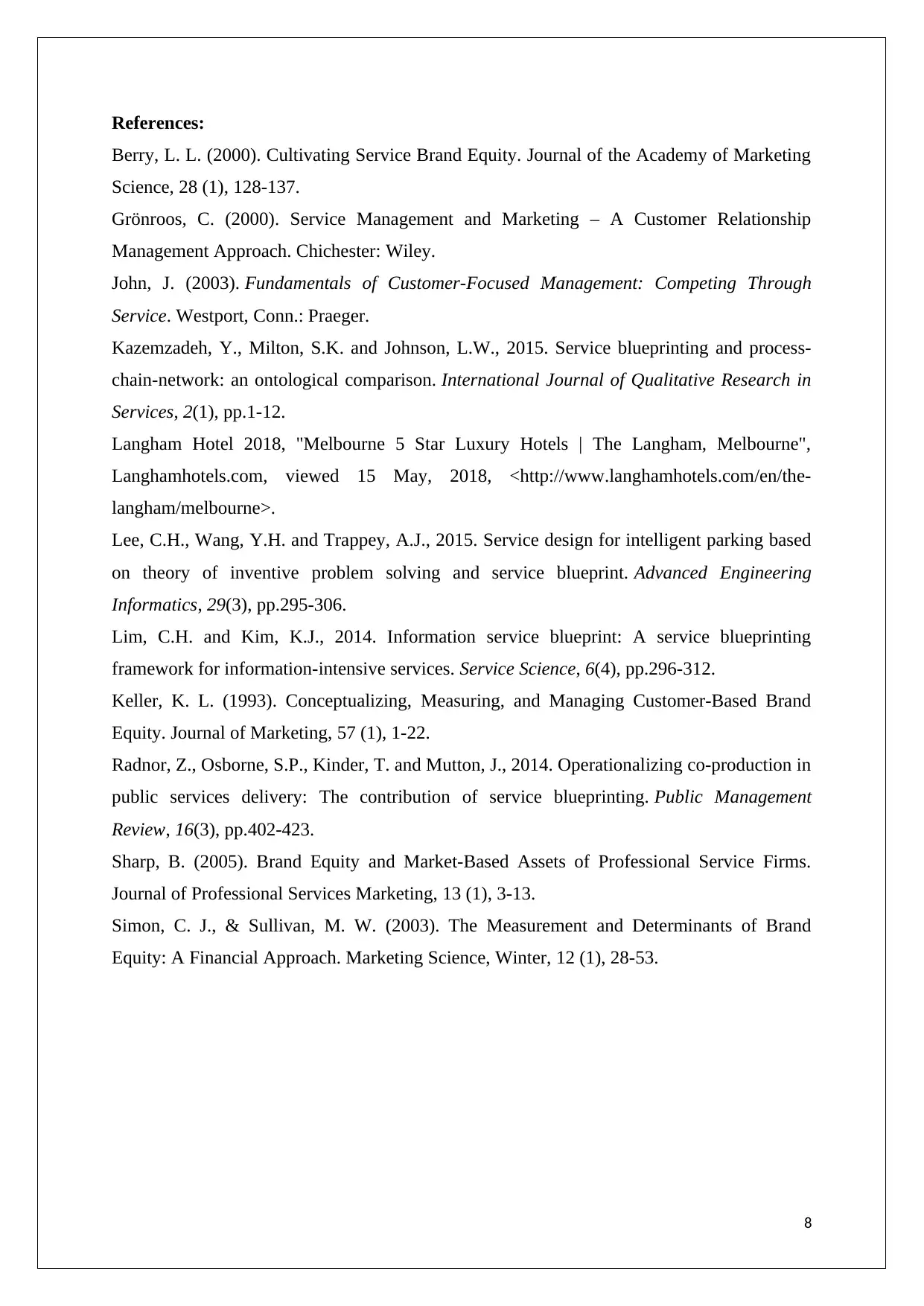
References:
Berry, L. L. (2000). Cultivating Service Brand Equity. Journal of the Academy of Marketing
Science, 28 (1), 128-137.
Grönroos, C. (2000). Service Management and Marketing – A Customer Relationship
Management Approach. Chichester: Wiley.
John, J. (2003). Fundamentals of Customer-Focused Management: Competing Through
Service. Westport, Conn.: Praeger.
Kazemzadeh, Y., Milton, S.K. and Johnson, L.W., 2015. Service blueprinting and process-
chain-network: an ontological comparison. International Journal of Qualitative Research in
Services, 2(1), pp.1-12.
Langham Hotel 2018, "Melbourne 5 Star Luxury Hotels | The Langham, Melbourne",
Langhamhotels.com, viewed 15 May, 2018, <http://www.langhamhotels.com/en/the-
langham/melbourne>.
Lee, C.H., Wang, Y.H. and Trappey, A.J., 2015. Service design for intelligent parking based
on theory of inventive problem solving and service blueprint. Advanced Engineering
Informatics, 29(3), pp.295-306.
Lim, C.H. and Kim, K.J., 2014. Information service blueprint: A service blueprinting
framework for information-intensive services. Service Science, 6(4), pp.296-312.
Keller, K. L. (1993). Conceptualizing, Measuring, and Managing Customer-Based Brand
Equity. Journal of Marketing, 57 (1), 1-22.
Radnor, Z., Osborne, S.P., Kinder, T. and Mutton, J., 2014. Operationalizing co-production in
public services delivery: The contribution of service blueprinting. Public Management
Review, 16(3), pp.402-423.
Sharp, B. (2005). Brand Equity and Market-Based Assets of Professional Service Firms.
Journal of Professional Services Marketing, 13 (1), 3-13.
Simon, C. J., & Sullivan, M. W. (2003). The Measurement and Determinants of Brand
Equity: A Financial Approach. Marketing Science, Winter, 12 (1), 28-53.
8
Berry, L. L. (2000). Cultivating Service Brand Equity. Journal of the Academy of Marketing
Science, 28 (1), 128-137.
Grönroos, C. (2000). Service Management and Marketing – A Customer Relationship
Management Approach. Chichester: Wiley.
John, J. (2003). Fundamentals of Customer-Focused Management: Competing Through
Service. Westport, Conn.: Praeger.
Kazemzadeh, Y., Milton, S.K. and Johnson, L.W., 2015. Service blueprinting and process-
chain-network: an ontological comparison. International Journal of Qualitative Research in
Services, 2(1), pp.1-12.
Langham Hotel 2018, "Melbourne 5 Star Luxury Hotels | The Langham, Melbourne",
Langhamhotels.com, viewed 15 May, 2018, <http://www.langhamhotels.com/en/the-
langham/melbourne>.
Lee, C.H., Wang, Y.H. and Trappey, A.J., 2015. Service design for intelligent parking based
on theory of inventive problem solving and service blueprint. Advanced Engineering
Informatics, 29(3), pp.295-306.
Lim, C.H. and Kim, K.J., 2014. Information service blueprint: A service blueprinting
framework for information-intensive services. Service Science, 6(4), pp.296-312.
Keller, K. L. (1993). Conceptualizing, Measuring, and Managing Customer-Based Brand
Equity. Journal of Marketing, 57 (1), 1-22.
Radnor, Z., Osborne, S.P., Kinder, T. and Mutton, J., 2014. Operationalizing co-production in
public services delivery: The contribution of service blueprinting. Public Management
Review, 16(3), pp.402-423.
Sharp, B. (2005). Brand Equity and Market-Based Assets of Professional Service Firms.
Journal of Professional Services Marketing, 13 (1), 3-13.
Simon, C. J., & Sullivan, M. W. (2003). The Measurement and Determinants of Brand
Equity: A Financial Approach. Marketing Science, Winter, 12 (1), 28-53.
8
1 out of 8
Your All-in-One AI-Powered Toolkit for Academic Success.
+13062052269
info@desklib.com
Available 24*7 on WhatsApp / Email
![[object Object]](/_next/static/media/star-bottom.7253800d.svg)
Unlock your academic potential
© 2024 | Zucol Services PVT LTD | All rights reserved.
